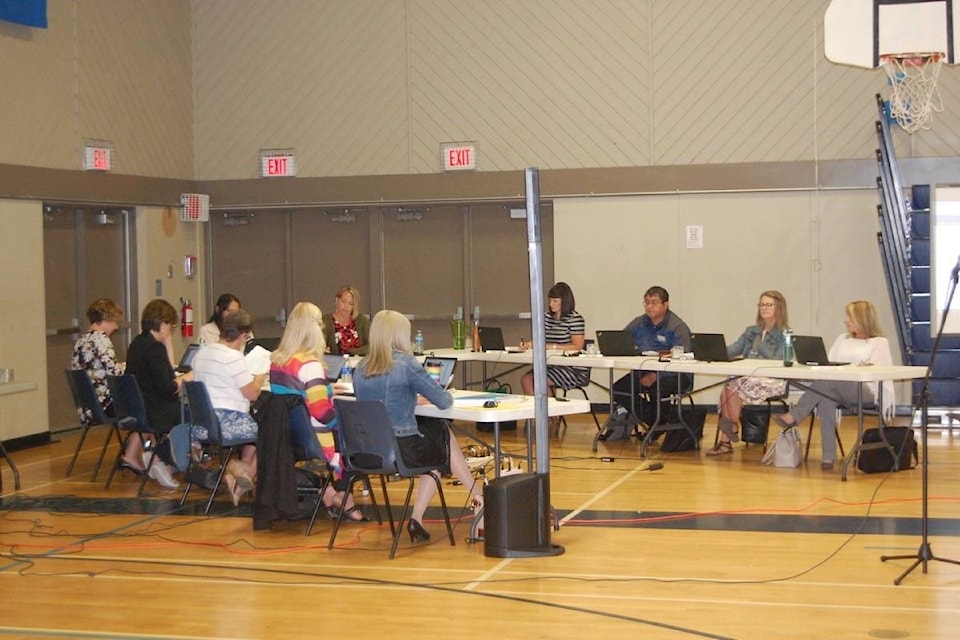At its open board meeting on June 5, the board of trustees of School District No. 74 (Gold Trail) voted four to three in favour of closing Lytton Elementary School (LES).
“School Closure Bylaw No. 2018-01, Lytton Elementary School” received first and second readings at a special open board meeting on May 22. The bylaw states that LES “be closed effective the later of June 30, 2018 or the completion of the renovation of Kumsheen Secondary School.” The bylaw was read for the third time, passed, and adopted on June 5.
Trustees Valerie Adrian (Rural Area B), Carmen Ranta (Rural Area D), Nancy Rempel (Rural Area C), and Vicky Trill (Village of Ashcroft) voted in favour of the bylaw, with trustees Larry Casper (Rural Area A), Orra Storkan (District of Lillooet), and Mavourneen Varcoe-Ryan (Rural Area E) voting against it. Lytton falls within Rural Area E.
In a series of presentations before the vote was taken, Lytton Mayor Jessoa Lightfoot, Lytton resident Gloria Raphael, consultant Farshid Rafiei, and Lytton First Nation Chief Janet Webster all spoke against the closure of LES. While it was acknowledged that the school has exceeded its lifespan, and that Lytton residents were not opposed to the idea of a K–12 school, opponents of the move said that the District had not given enough time to the process and were making their decision before all the information had been collected.
The question of closing LES has been an ongoing subject of discussion for the District since 2005, gaining ground in recent years as elementary schools in Clinton and Ashcroft have been closed and the high schools in those communities converted to K–12 facilities.
The presenters made it clear that their preferred solution was a newly-built K–12 school in Lytton, rather than a repurposed Kumsheen Secondary. The nkshAytkn Caring for Our Children Lytton committee has, for the last six months, been exploring ways to get a new school built for the community.
“We don’t want a K–12 school at the Kumsheen site,” said Lightfoot. “Make a good decision for our community. Just being thrown to the winds with no clear future causes great anxiety.”
Raphael asked the board to delay third reading of the bylaw. “[Minister of Education] Rob Fleming is very interested in working with the community. We’d like to explore some options with you, and move forward with you for a future our children would be proud of.”
Rafiei presented some of the preliminary findings of a feasibility study about closing LES and converting Kumsheen Secondary, arguing that in the long run, the District will pay more to convert Kumsheen than to build a new school. “A new K–12 school is not only good for Lytton for generations to come, it would save the taxpayers of the province money.”
Webster said that as a leader, she asked the board to reconsider. “Eighty-five to 90 per cent of our students are First Nations. I don’t feel our children need second-hand or second-best. We’re the first peoples of these lands. We want to stand here with you, be partners.”
After the vote, SD 74 board of trustees co-chair Valerie Adrian said “School closures are always very emotional, and amalgamation is never easy. We started looking at this in 2005, and the students are in a school that isn’t very pretty.
“I feel that we’ve been cast as an evil group of people who aren’t taking into consideration the feelings of community members. But there have been 13 years of stop and start in this process. Our first priority is the students, and our second is working with the community on a K–12 school.”
Rempel—whose community of Clinton underwent a similar process when Clinton Elementary was closed and David Stoddart School became a K–12 facility—pointed out that, like Kumsheen, David Stoddart is on a highway. “But it’s a beautiful, vibrant school. We settled for renovations, not a new school, and our students are very happy.”
Afterward, Raphael said that “As a community we’ve said all along that we want a new building, and I’m very disappointed; not necessarily that we didn’t get a new building, but that we weren’t provided with an opportunity for dialogue over the options.
“The community fundraised and paid for a feasibility study, but there wasn’t enough time to get it done before [today’s] meeting. I believe the board made this decision before they had all the information. I don’t believe this has to be the end, but how do we move forward? I’m disappointed and frustrated, but still hopeful.”
Webster said that she was disappointed by the decision. “This could have worked, but we needed more time. We had momentum going in, with support from all the chiefs in the area, and we didn’t want to lose that momentum.
“We’re okay with a K–12 school, but wanted a new building. I pray that we can reconsider this, for the future of our children.”
School District No. 74 Secretary-Treasurer Lynda Minnabarriet said that LES would remain open for at least the 2018–19 school year. “The school won’t be closed until Kumsheen Secondary is renovated. We now enter into a timeline to do that. The community will provide input into the design [of the renovations] and what that project looks like.”
